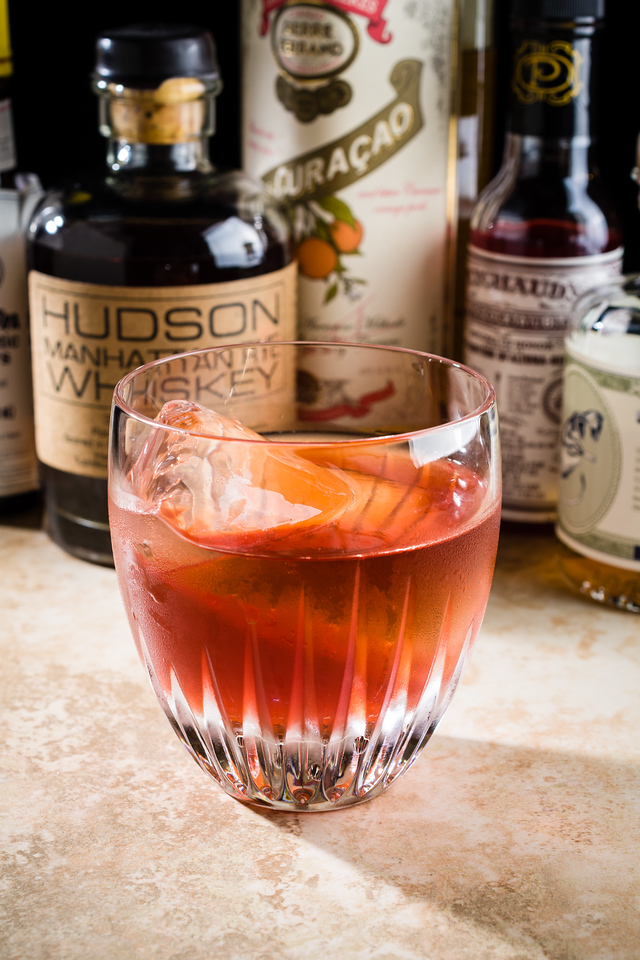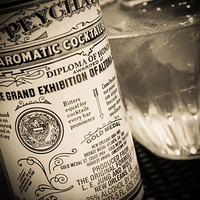Given its name, you’d expect the Creole Cocktail to be from New Orleans. You’d be right—sort of.
The Creole is really more of a family of cocktails—there is no single example of what we might call the “historically correct” Creole Cocktail. There are at least four main branches on the Creole family tree, though only two of those branches seem to have survived into the twenty-first century.
The three earliest versions of the Creole appeared a few years before Prohibition—one in New Orleans, one in Chicago, and one in New York.
The Chicago Creole Cocktail
The earliest published Creole Cocktail is the Chicago one, from Jacques Straub’s 1913 Manual of Mixed Drinks. Straub’s version is absinthe-heavy, and that, combined with the drink’s name, suggests that Straub was trying to evoke a bit of New Orleans for his Chicago customers.
Jacques Straub, 1913
- ⅓ jigger absinthe
- ⅔ jigger Italian vermouth
Shake well
Apparently, the Waldorf Hotel in New York City also served the the absinthe-based version. A. S. Crockett’s Old Waldorf Bar Days (1931) recounts that the Creole was on the Hotel’s bar list in the pre-Prohibition era, following Straub’s formula, with the addition of a dash of orange bitters.
Straub’s Creole tastes just as you’d expect: like slightly sweetened absinthe with a strong herbal background. The Waldorf’s orange bitters are not an improvement.
It’s a good drink, but there really isn’t enough light between this version of the Creole and the classic absinthe service (absinthe-water-sugar) to make it worthwhile, especially if your absinthe is strongly herbal to begin with.
As it turns out, this branch of the Creole family tree seems to have been pruned away fairly quickly, likely a victim of Prohibition and the fact that absinthe was outlawed in the US just before Straub’s manual made it to press.
The New Orleans Creole Cocktail
The second pre-Prohibition version of the Creole actually comes from New Orleans. According to David Wondrich, this one is from Henry C. Ramos, famously the inventor of the Ramos Gin Fizz.

Ramos’s Creole is a whiskey drink, not far removed from the Sazerac:
Creole Cocktail
Henry C. Ramos, c. 1915?
- 1½–2 oz whiskey
- 2–3 drops curaçao
- 4–drops Peychaud’s bitters
- 3–4 drops Angostura bitters
- small lump of sugar
- absinthe to coat glass
Crush the sugar in a mixing glass with the bitters; add curaçao, whiskey, and ice, and stir until cold. Coat a rocks glass with absinthe for aroma, optionally add ice, and strain the cold mix into the glass. No garnish.
In Ramos’s version, which is roughly contemporary with Straub’s, the heavy dose of absinthe is reduced to an aromatic wash on the serving glass, and the drink is sweetened with a touch of orange curaçao. It’s basically a Sazerac with a hint of orange.
The nose, as expected, is all anise and wormwood, the absinthe evaporating from the sides of the glass above the liquid. Those notes disappear, of course, as the absinthe wash dries, leaving a slight herbality, the faintest notion of citrus, and the emerging aromas of the whiskey.
The initial taste is a balance of the sweet-spicy combination of the sugar and bitters, and finally there is the longer taste of the sweetened whiskey.
The New York Creole Cocktail
This third Creole is one I used to think of as a post-Prohibition invention from London; Chris Hannah, formerly of New Orleans’ French 75 and now at Jewel, pointed me toward the recipe in Hugo Ensslin’s 1916 Recipes for Mixed Drinks — which makes it a New York cocktail from the last major bar manual published before Prohibition closed U.S. bars.
Ensslin’s contribution to the Creole family tree is roughly contemporaneous to Ramos’s New Orleans version; it includes whiskey, Bénédictine, Italian vermouth, and the then-popular, now nearly-unobtainable bitter Amer Picon.
Curiously, it was this version that best survived Prohibition. Harry Craddock lifted it nearly verbatim for his 1930 Savoy Cocktail Book, and that manual’s popularity assured the Creole’s survival into the modern age of cocktailing. Both William Boothby and Charles Duffy published it again in 1934, with Boothby giving it the name we still most often encounter, the “Creole Cocktail No. 2“.
(Trader Vic Bergeron muddied the waters a few years later by renaming it “Creole Cocktail No. 1” in his 1947 Bartender’s Guide—and of course, he called Ramos’s curaçao version “Creole Cocktail No. 2.” Very helpful.)
Bartenders seem to have settled on Boothby’s numbering:
Hugo Ensslin, 1916. (Also Craddock, Boothby, Duffy)
- ½ whiskey
- ½ Italian vermouth
- 2 dashes Amer Picon
- 2 dashes Bénédictine
Stir with cracked ice; strain into a chilled cocktail stem with a twist of lemon peel.
Creole Cocktail No. 2 turns out to be an exercise in substitution.
This version finally foregoes absinthe altogether, and presents a more Manhattan-like structure, reminiscent, too, of the Vieux Carré and the Brooklyn.
First, the proportions: half whiskey and half Italian vermouth is a bit sweet for modern tastes. I prefer rye whiskey, and in this drink the slightly bitter Punt e Mes instead of standard sweet vermouth. I increase the whiskey proportion to 3:1 or 4:1 — 1½ or 2 oz rye and ½ oz Punt e Mes.
And then, there’s the Amer Picon. Amer Picon is (was?) an orange flavored French bitter, along the lines of the Italian amaros. It has a long history; the short version is that it is nearly unobtainable outside of Europe, and, even if it were, it is no longer made according to the recipe that would have been current when Ensslin, Craddock, Duffy, and Boothby were adding it to their Creole Cocktails.
 Bartenders have gone to some lengths to substitute for, or even to emulate, Amer Picon. Some years ago, Seattle bartender Jamie Boudreau published an Amer Picon emulation that he called “Amer Boudreau;” it has a good reputation, and seems to be the DIY standard for those with patience to formulate and age it.
Bartenders have gone to some lengths to substitute for, or even to emulate, Amer Picon. Some years ago, Seattle bartender Jamie Boudreau published an Amer Picon emulation that he called “Amer Boudreau;” it has a good reputation, and seems to be the DIY standard for those with patience to formulate and age it.
But if you’re making only the occasional Creole No. 2, you might want a quicker, if not so accurate, substitution.
Boudreau’s formula suggests a way to connect with the general flavors, if not the nuance, of Amer Picon. His emulation is based heavily on Ramazzotti and orange bitters, and a quick substitution of a couple dashes of each of those ingredients, while historically imprecise, brings much of the original Amer Picon’s earthy and orange flavor notes to the drink.
What about that Gin thing?
There is a fourth Creole line that showed up in a couple bartender’s manuals in the mid-’40s. Gale and Marco, in their 1945 The How and When, and Trader Vic Bergeron, in his 1947 Bartender’s Guide, listed an equal-parts gin-sherry-lemon juice cocktail; that version seems to have disappeared as suddenly as it appeared.
I’d be interested to know where such a dramatically different formula came from. It’s sort of like a very stripped-down, unsweetened, tropical-style summer drink, a combination of flavors that almost—almost—works well, a half-finished experiment looking for the right conclusion.
Of the four main lines of Creole Cocktail development, my favorite is Ramos’s New Orleans style Creole, probably because it has such a close resemblance to my beloved Sazerac. It has everything good about the Sazerac, plus a bonus hint of orange to differentiate it from the venerable classic. Where Ramos used “drops” of curaçao and bitters, I prefer to use dashes, but that’s just a matter of emphasis. The whiskey, the absinthe, the bitters, and the light sweetness all say Sazerac to me.
It makes the Creole a welcome and comforting cocktail, and that’s enough for me.
“The Creole Cocktail Four Ways” at cold-glass.com : All text and photos © 2017–2022 Douglas M. Ford. All rights reserved.

Weird. I see Boothby has a “Crutch” cocktail in his 1934 edition that seems Trader Vic is oddly referring to: “Crutch cocktail. Same as Creole cocktail.” Its the gin sherry lemon. How do these things get confused? Is it just because it was the days before the internet and things tended to get “telephoned” a little bit more back then?
Also if you’re not aware of this collection you should be : https://euvs-vintage-cocktail-books.cld.bz/#
Yes, I noticed that, too. I decided to leave it out of the story in the interest of simplicity, but it is an intriguing bit of marginalia. The Creole Cocktail story is a very tangled one, and I have absolutely no idea how some of these connections (or missed connections) arise. I suspect you’re in the right of it with the “telephone” theory. Typos, speculation, and bad memories can account for a lot of things in history, and not just cocktail history.
Thanks for adding the EUVS link; that’s a very fun and useful collection, and I recommend it to anyone who likes to root around in the history and evolution of the cocktail.
FANTASTIC ARTICLE